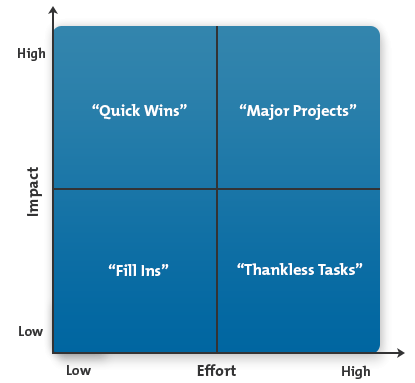The Action Priority Matrix
Making the Most of Your Opportunities
Whether they're bright ideas to pursue, exciting opportunities, or interesting possibilities, most of us have many more activities on our "wish lists" than we have time available to work on them.
By choosing activities intelligently, we can make the very most of our time and opportunities. However, by choosing badly, we can bog ourselves down in time-depleting, low-yield projects that stop us moving forward.
This is where an "Action Priority Matrix" can be useful. These simple diagrams help you choose the activities you should prioritize and the ones you should avoid, if you want to make the most of your time and opportunities.
How do you prioritize the tasks on your To-Do List?
About the Tool
Action Priority Matrices* (see figure 1, below) show you how to prioritize activities to make the most of your time, energy, and talents.
This is useful, because we rarely have time to complete all of the tasks and projects on our wish lists. When we use the matrix to choose activities intelligently, we can spend more of our time on the high-value activities that keep us moving forwards.
We can also drop tasks that contribute little.
Figure 1 – The Action Priority Matrix

To use the matrix, you score tasks based firstly on their impact and secondly on the effort needed to complete them.
You then use your scores to plot these activities in one of four quadrants:
Quick Wins (High Impact, Low Effort)
Quick wins are the most attractive projects, because they give you a good return for relatively little effort. Focus on these as much as you can.
Major Projects (High Impact, High Effort)
Major projects give good returns, but they are time-consuming. This means that one major project can "crowd out" many quick wins.
Fill Ins (Low Impact, Low Effort)
Don't worry too much about doing these activities – if you have spare time, do them, but drop them or delegate them if something better comes along.
Thankless Tasks (Low Impact, High Effort)
Try to avoid these activities. Not only do they give little return, they also soak up time that you should be using on quick wins.
Tip:
Once you understand the principles behind the Action Priority Matrix, you'll probably find that you apply it quickly and intuitively to new tasks and projects.
How to Use the Tool
To use the Action Priority Matrix, download our worksheet and then follow these steps:
Step 1
List the major activities that you want to or need to complete.
Step 2
Score these on impact (from, say, 0 for no impact to 10 for maximum impact), and on effort involved (from, say, 0 for no real effort to 10 for a major effort).
Step 3
Plot the activities on the Action Priority Matrix, based on your scores.
Step 4
Prioritize appropriately, and delegate or eliminate low-impact activities.
Tip:
Use common sense to interpret the lines that separate the four quadrants. After all, there's only a small difference between a 4.9-impact activity defined as a "thankless task" and a 5.1-impact task defined as a "major project."
Variants of the Tool
The approach we describe above explains how you can use the Action Priority Matrix as an informal or personal way of prioritizing tasks. However, you can use this approach on a larger scale by using, for example, "financial return" as the scale on the vertical axis, and "person months" on the horizontal axis.
Alternatively, you could substitute "feasibility" for "effort" on the horizontal axis to prioritize projects based on your ability to implement them. (This variant is sometimes known as the "Impact/Feasibility Matrix.")
Tip:
Also see our article on Eisenhower's Urgent/Important Principle – this is a similar tool that you can use to manage your priorities, and it is particularly useful for bringing "firefighting" under control.
Key Points
The Action Priority Matrix is a simple tool that helps you choose which activities to prioritize, and which activities to delegate or eliminate. This helps you make best use of the opportunities available to you.
The matrix has four quadrants:
- Quick wins.
- Major projects.
- Fill ins.
- Thankless tasks.
To use the matrix, make a list of your ongoing activities and goals. Score each task on impact and effort, using a 0 to 10 scale. Next, plot your activities on the matrix, and then prioritize, delegate, or drop activities appropriately.
* Originator unknown. Please contact customer.helpdesk@mindtools.com if you know who the originator is.
This site teaches you the skills you need for a happy and successful career; and this is just one of many tools and resources that you'll find here at Mind Tools. Subscribe to our free newsletter, or join the Mind Tools Club and really supercharge your career!






Good to hear that you found value in the article.
Bill
Mind Tools Team